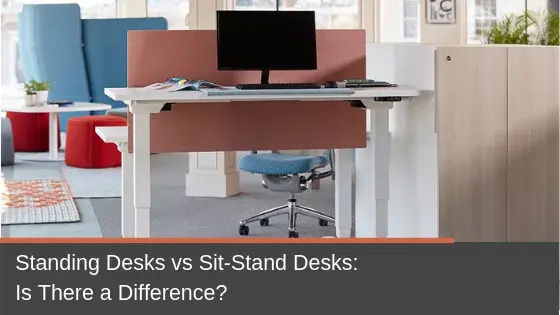Search for topics or resources
Enter your search below and hit enter or click the search icon.
January 7th, 2025 | 3 min read
By CJ Porteous

By now, we’ve all heard the warnings about the dangers of sitting too much. But is standing while working really the best way for employees to build more movement into their days? And if so, are fixed standing desks the answer or are sit-stand desks the best way to go?
Before you go all-in on one or the other, there are a few things to consider.
There’s little doubt; most modern office workers sit too much. On average, Canadians sit about 10 hours every day – mostly at work. And our penchant for sitting is taking a toll on our health, our moods and our waistlines. While everyone seems to agree on that, there are differing views on how much standing we should do to counter the downside of desk work.
Standing desks are one of the most popular trends in office ergonomics, and their popularity shows no sign of letting up. A 2017 survey of HR professionals indicated that providing standing desks to employees was the fastest-growing wellness benefits trend. As well, the global standing desk market is expected to hit US $2.8 billion by 2025.
There are two main categories of standing desks: fixed-height standing desks that allow an employee to stand while working and sit-stand desks that can be adjusted to either sitting or standing height. Let’s look at some of the pros and cons of standing desks vs sit-stand desks.
Research shows standing can make us more focused and productive by increasing engagement on tasks and improving working memory. This makes standing desks a good fit for tasks that require short bursts of energy like responding to emails or talking on the phone. They also provide convenient hubs for team collaboration.
There are a few reasons you may want to consider a fixed-height standing desk. Firstly, fixed-height standing desks tend to be cheaper than sit-stand desks with a wide variety of inexpensive options from which to choose. Secondly, fixed-height desks have fewer moving parts and are therefore often easier to install. The simplified design also provides excellent stability and makes it easier to manage cords and cables.
Standing desks are the right choice if you want to create a workstation that incorporates exercise equipment like a treadmill or stationary bike with a desk. For workers using fixed-height standing desks, it’s vital for them to take breaks and ensure their desks are appropriately configured with the top of the computer screen at eye level.
The biggest argument against fixed standing desks is that they take an all-or-nothing approach to standing. While studies have shown that standing at work has significant health benefits, helping you lose weight and reducing the risks of strokes and heart attacks, other research has shown that too much standing may be almost as bad as sitting for hours at a time.
Prolonged standing puts stress on your knee and hip joints and can cause you to slouch, which is terrible for your posture.
And the reality is: sitting is not all bad. Not only does it take the load off your legs; it may also help you think better. Many people prefer to sit while working on projects that require a lot of creative thinking, complex problem solving or the use of fine motor skills. They key is not to sit or stand too long, and that’s where sit-stand desks come in.
The primary benefit sit-stand desks offer is that they can be easily adjusted from sitting height to standing height to accommodate different tasks or to add a variety of movement to a worker’s day.
This flexibility gives users a chance to change things up and sit or stand when their bodies tell them. Current research suggests a 3:1 ratio between standing and sitting. So, for every 45 minutes, workers spend standing, they should sit down for 15. The key is to keep the body moving from one position to another at least once an hour throughout the day.
Along with the health benefits of sit-stand desks, there are also productivity benefits to giving employees a choice. A 2016 study showed call center employees who were given sit-stand desks were 46 percent more productive than their colleagues who sat all day.
So, if you’re looking for flexibility and maximum health benefits, sit-stand desks are the best choice. If workers alternated between sitting and standing once every hour, that’s enough movement to keep them from experiencing many of problems that are taking a toll on their health and productivity.
Wish you could read further about how sit stand tables and ergonomic accessories can increase productivity in your office? You can! We published an in-depth guide to Office Ergonomics, check it out today!
Cory Porteous
Director of Marketing & Inbound Business Development
Office Interiors
If you’re ready to start improving productivity, streamlining processes, and love the way you work through optimized workspaces and office technology, contact us today. Our team of experts is here to help!
Topics: